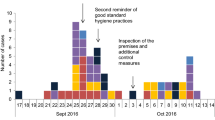Summary
On November 9, 2004, a resident in a nursing home experienced a severe episode of vomiting in the dining room, in the presence of most of the other residents and members of staff. Following that episode, 17 of the 23 (73.9%) other residents and 7 of the 18 (38.9%) staff members fell ill with diarrhea and/or vomiting in the period up to November 17. A second cluster of gastroenteritis occurred between November 11 and 28, 2004, in a nearby hospital to which eight cases among the nursing home residents had been referred. Ten of 46 (21.7%) other hospital patients and 18 of 60 (30%) members of the hospital staff suffered from vomiting or diarrhea. Epidemiological and laboratory investigations proved a causal relationship between the two institutional clusters of short-lived gastroenteritis related by time and place, and identified Norovirus genotype GGII.4 (Jamboree-like) as the causative pathogen. Control measures for Norovirus, based on epidemiological and clinical features of the outbreak, were effectively implemented in the nursing home without waiting for virological confirmation. At the hospital, specific measures were not implemented until after virological confirmation of the causative agent, by which time 16 cases had already occurred. In a suspected Norovirus outbreak it is of great importance – especially within closed and semiclosed settings – to implement control measures as soon as possible, even before laboratory confirmation of the agent.
Zusammenfassung
Am 9. November 2004 kam es bei einer 91-jährigen Altenheimbewohnerin während des Aufenthaltes im Speisesaal in Anwesenheit anderer Heimbewohner zu schwallartigem Erbrechen. Siebzehn der 23 anderen Heimbewohner und 7 der 18 Beschäftigten erkrankten in der folgenden Woche an Durchfall oder Erbrechen (Befallsrate, 73,9 % bzw. 38,9 %). Ein zweiter Gastroenteritis-Ausbruch zeigte sich zwischen 11. und 28. November in einem nahe gelegenen Krankenhaus, in dem 8 Fälle vom Altenheim wegen schwerer Brechdurchfälle stationär behandelt wurden. Zehn von 46 Patienten (21,7 %) der betroffenen Abteilung (exkl. Patienten des Altenheims) und 18 von 60 Beschäftigten (30 %) erkrankten. Epidemiologische und mikrobiologische Untersuchungen belegten eine ursächliche Beziehung zwischen den zwei institutionellen Häufungen kurzlebiger Gastroenteritis verursacht durch Norovirus-Genotyp GGII.4 (Jamboree-like). Im Altenheim wurden aufgrund klinisch-epidemiologischer Hinweise Ausbruchskontrollmaßnahmen gegen Verbreitung von Norovirus noch vor Einlangen der labordiagnostischen Bestätigung erfolgreich implementiert. Im Krankhaus wurden spezifische Maßnahmen erst mit Vorliegen der Labordiagnose Norovirus nach Auftreten von 16 Erkrankungsfällen umgesetzt. Bei Verdacht auf institutionellen Gastroenteritis-Ausbruch durch Noroviren sollten entsprechende Hygienemaßnahmen unverzüglich, ohne Abwarten der labordiagnostischen Bestätigung implementiert werden.
Similar content being viewed by others
Author information
Authors and Affiliations
Corresponding author
Rights and permissions
About this article
Cite this article
Schmid, D., Lederer, I., Pichler, AM. et al. An outbreak of Norovirus infection affecting an Austrian nursing home and a hospital. Wien Klin Wochenschr 117, 802–808 (2005). https://doi.org/10.1007/s00508-005-0473-1
Received:
Accepted:
Issue Date:
DOI: https://doi.org/10.1007/s00508-005-0473-1




